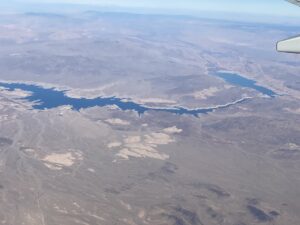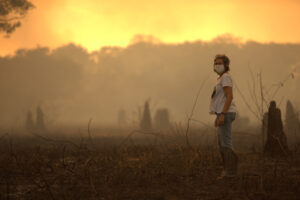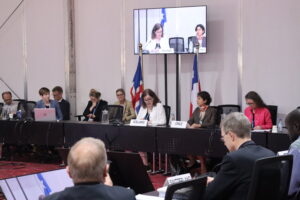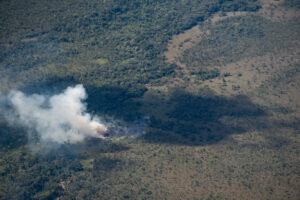Here’s what will happen if Colorado River system doesn’t recover from ‘historic drought’
The river system provides water to 40 million people.

Located in Eastern Alaska, the Yukon Flats National Wildlife Refuge is larger than many U.S. states. It’s a roadless landscape of rocky mountain outcroppings, flat meadows, treeless tundra, and dense spruce forests, bisected by the Yukon River and dotted with thousands of lakes and wetlands. Several Alaska Native communities call the refuge home and subsist off of its natural resources. This diverse, expansive wilderness is well adapted to fire, and it’s not uncommon to see pink fireweed blooms or young grass and seedlings sprouting from burn scars.
But the relationship between fire and land here—as in many places—has been changing as the climate warms. Yukon Flats sits atop ancient, ice-rich ground, called Yedoma permafrost, formed during the last ice age. Thawing Yedoma is a significant source of carbon dioxide and methane emissions to the atmosphere. Fire, made more intense and frequent by climate change, threatens to accelerate that thaw. In an effort to preserve carbon stores, the U.S. Fish and Wildlife Service recently dedicated 1.6 million acres of the Yukon Flats refuge to piloting a new firefighting regime, one designed to protect carbon, in addition to human lives and property.
Science builds the case for policy change
This decision was, in part, influenced by research led by Dr. Carly Phillips, during her time as a research scientist at the Union of Concerned Scientists, alongside Woodwell Climate Senior Science Policy Advisor, Dr. Peter Frumhoff, and Associate Scientist, Dr. Brendan Rogers. In a 2022 paper in Science Advances, the group quantified the threat boreal forest fires pose to climate goals. Wildfires in boreal North America alone could, by mid-century, use up 3% of remaining global carbon dioxide emissions associated with keeping temperatures below the Paris Agreement’s 1.5°C limit. This is a conservative estimate—the authors suggest the true numbers could be even larger as the accelerating effect of fires on permafrost thaw, and the release of other greenhouse gasses, were not included in the analysis.
The study also examined the cost-effectiveness of combatting those fires as a potential climate solution. Molly Elder, an economics and public policy Ph.D. candidate at Tufts, performed an analysis of data from across Alaska’s fire management zones and found that actively suppressing boreal fires could cost less than 13 dollars per ton of carbon dioxide emissions avoided—putting it on par with other carbon mitigation solutions like onshore wind or utility-scale solar.
“The work we did in this project proved and quantified what the management community already knew, which is that management is effective at reducing burned area when fires are actively suppressed,” says Elder.
Combating boreal fires could provide much needed mitigation, and at a low cost, but there are some logistical obstacles between the hypothetical model and actual implementation. Typically, in Alaska, boreal forest fires are left to burn unless they present a risk to human life or property. This is partly because these forests are fire-adapted, but also partly due to the sheer vastness of boreal wilderness. With limited resources, it is not always practical or possible to track down and put out a fire, especially in a place without roads like Yukon Flats. Firefighters are already stretched thin with lengthening and increasingly high-intensity fire seasons.
So the research group worked with the fire management community in Alaska, facilitated by the Alaska Fire Science Consortium, to better understand the needs of firefighters and demonstrate the co-benefits of fire suppression in addition to preserving carbon.
“Many of the fire managers expressed how stretched their resources already were and resistance to the idea that yet another mandate would be added to their plate,” says Dr. Phillips. “However, after discussing the implications of our research, and the ambition that additional funding would come with any mandate, we got more buy-in.”
Fire suppression: It’s not a dirty word
The other concern managers raised was whether fire suppression would ultimately be successful in achieving their goals. Historically, fire suppression efforts in the US have been counterproductive to protecting forests.
In the late 1800s, lack of understanding of the ways Indigenous communities in Western states have used fire to maintain healthy forests resulted in decades of near-total suppression of fire in the region. In many western US forests, (adapted to what Dr. Rogers calls “high-frequency, low-intensity” fire) suppression allowed highly flammable, dry vegetation—which would normally be periodically burned away—to build up. When fires did spark, they were then capable of growing to a size and intensity that could damage, rather than activate, the forest.
But in boreal Alaska and Canada, it’s just the opposite. The spruce-dominated forests are adapted to high-intensity fires that only return every hundred or so years. As climate change speeds up the return of fires with hotter and drier conditions, boreal forests have begun to suffer major losses.
“The frequency of boreal fires, ultimately, is increasing. In many places we’re seeing more reburning and larger burned areas,” says Dr. Rogers. “Climate change and human actions are shifting that fire regime out of its historical range into this new realm. So the whole idea of fire suppression in the boreal is to keep fires closer to historical levels, to which the systems and fauna are adapted. Suppression can help delay permafrost degradation, limiting carbon emissions and buying us time to reach our climate targets.”
Past missteps with fire suppression have made fire managers cautious, though. Lisa Saperstein, Regional Fire Ecologist with U.S. Fish and Wildlife, notes that, with limited resources, priorities in intense fire seasons will have to shift to protecting human settlements over carbon and permafrost. But, given the co-benefits of keeping fire activity to historic levels—and the urgency of reigning in emissions in any way we can—managers in Yukon Flats were willing to try.
“This type of shift in values is always difficult, especially when the outcome is uncertain. Support from leaders of fire management organizations, in addition to land managers, has been a key factor in this effort moving forward,” says Saperstein.
If a fire starts in the woods, how do you fight it?
This change in tactics won’t mean that every fire that ignites will be put out—both impractical and unhelpful from an ecological perspective—but it will mean more aggressively targeting fires when they arise. Since the 1980s, when fire was detected in Yukon Flats, it would be monitored by the Alaska Fire Service, but not suppressed, except when presenting a threat to human communities.
“This pilot project is a new twist to a long-standing partnership between the U.S. Fish and Wildlife Service and Alaska Fire Service. For select areas of the Refuge, now if a fire start is detected, we ask the Alaska Fire Service to only send a crew if they are confident in 100% containment within three days,” says Yukon Flats Refuge Manager, Jimmy Fox.
The suppression teams will target fires that they judge as “quick fixes”, curbing the potential for them to grow into large, stand-replacing sized blazes. If a fire becomes too big to fight quickly, the teams revert to the old tactic of simply monitoring.
“If a crew is deployed, we ask that they cease suppression and return to base after three days, regardless of containment status,” says Fox. “This request is grounded in concern for the Alaska Fire Service having resources available if communities become threatened from other fires.”
Fox says refuge management and Alaska Fire Service members will stay flexible as the pilot project unfolds so they can respond to changing conditions.
“In conservation, we tend to focus on the technical aspects of a challenge and avoid the difficulties that come with asking ourselves to adapt,” says Fox. “This pilot project is both adaptive and technical. It has required me to stay curious and listen. It has required me to learn new information, and share it in a way that is comprehensible. It’s required being comfortable with uncertainty, and yet standing in purpose. It has been a learning journey so far, and will continue to be.”
Putting models to the test
On the research side, the team at Woodwell Climate hopes this new strategy will present an opportunity to study the practical implementation of fire suppression as a climate solution.
“This is the proof of concept,” says Dr. Frumhoff. “This is the opportunity to really see in a rigorous way whether we can apply this solution at a meaningful scale and gain meaningful carbon benefits with relatively modest cost. And it’s directly traceable to the conversations that the research team had with fire managers.”
The 1.6 million acres slated for fire suppression are small compared to the 8.6 million that comprise the entire refuge, or the 5.6 billion acres of permafrost in the northern hemisphere, but it’s a very important start. Research and analysis of the effectiveness of this solution could aid its expansion to other regions of the Arctic.
“It’s a big moment, because, while it’s obviously a relatively small area compared to all of Alaska, 1.6 million acres is still a lot of land,” says Dr. Rogers. “We’re hoping that it’s a jumping off point and can translate to other refuges and other agencies with the addition of proper funding and staffing.”
And each summer, the case for protecting permafrost and boreal carbon, while working to dramatically reduce emissions from fossil fuels, continues to grow.
“Every year that goes by, as fires intensify and climate change gets worse, this message might resonate just a little more, ” says Dr. Rogers. “Because it’s a problem that’s not going away if we do nothing about it. And we can do something about it.”
Indigenous Amazon forests absorb noxious fumes and prevent diseases from wildfires, study suggests

A new study published in Nature estimates that forests in Indigenous lands in Brazil’s Amazon have the potential to absorb over 7,000 tons of noxious fumes from forest fires every year, preventing about 15 million cases of respiratory and cardiovascular diseases annually, which would otherwise cost $2 billion to Brazil’s public health system.
The effect on the health of populations adds to the environmental impacts of fires in the Amazon forest, which are mainly caused by deforestation and contribute to increased emissions.
What was not yet known was the level of those damages, the costs and the ability of the Amazon forests in Indigenous lands to absorb the pollutants, said the study’s authors.
A Homer scientist is bringing changes in Arctic permafrost into high-resolution

With permafrost thaw in the Arctic rapidly outpacing previous projections, researchers are racing to understand the impacts of an increasingly unstable future.
After growing up in Sweden, Anna Liljedahl moved to Alaska to study hydrology at the University of Alaska Fairbanks. She now lives in Homer, where she conducts research as an associate scientist at the Woodwell Climate Research Center, focusing on how climate change is impacting water in Arctic ecosystems.
Read more on Alaska Public Media.
In October 2022, Scotty Creek Research Station—a prominent climate research facility in the Northwest Territories (NWT) of Canada—was almost entirely consumed by an unusually late-season wildfire. With five out of nine of the station’s buildings destroyed and an estimated two million dollars of damage to onsite housing, research equipment, solar panels, and lab space, the fire was a “gut punch” to one of the only Indigenous-led climate research stations in the world. But, with support from Permafrost Pathways, the Łı́ı́dlı̨ı̨ Kų́ę́ First Nation (LKFN) who now lead the facility are focusing their attention on rebuilding.
A cruel irony: when the impacts of climate change thwart climate research
The fire that destroyed Scotty Creek Research Station had been active for almost 100 days before finally reaching the camp. Usually, the area sees rain or snow for almost half of the month in October, and historically, it has even snowed as much as 12 inches with temperatures sometimes dropping as low as negative two degrees Fahrenheit (-19 degrees Celsius). But drier conditions, abnormally warm weather, and heavy winds in late 2022 led to an extended and extraordinarily active fire season in the NWT—which exceeded its 10-year average of total fires burned, with over 1.3 million acres affected by fire.
“It was just heartbreaking,” William Alger, LKFN’s lead Dehcho guardian at Scotty Creek told CKLB Radio after being the first to witness the extensive destruction left in the fire’s wake last fall. But now, “it’s just a matter of picking up the pieces and figuring out where we go from here,” Alger said.
Climate change is making it harder to conduct climate research, a harsh reality that the fire at Scotty Creek tragically represents. The obstruction of data collection and ecological stewardship caused by frequent environmental disasters is becoming a recurring setback, presenting a daunting challenge for carrying out this work in a perpetually warming world.
“I can’t help but notice the irony that a subarctic research station dedicated to understanding climate change burned down in mid-October due to a wildfire,” William Quinton, a professor at Wilfrid Laurier University and the original founder of Scotty Creek Research Station, said in an interview for CBC News.
The unusual time of year made it difficult to attack the fire, as temperatures suddenly plummeted and strong winds began to pick up. For several days leading up to the weekend of October 15th, the Scotty Creek team anxiously watched the fire burn closer and closer to the camp, mentally preparing for the worst but hoping for the best.
Unfortunately, common techniques for combating wildfire, such as cutting fire breaks and setting up sprinklers, failed when the cold snap led to the territory’s environment and natural resources department (ENR) removing sprinkler systems they feared would freeze—drawing criticism from LKFN—and changes in wind direction forced the early evacuation of research teams and firefighting crews helping out on the ground. Additionally, helicopters trying to combat the flames from the air were unable to pull water from surrounding water bodies that had begun to freeze over.
“When we’re fighting fires and protecting structures, it is highly unusual for there to be the threat of freezing temperatures,” Mike Westwick, a wildfire information officer for the territory wrote in an email to CBC News.
Impacts from the burning of Scotty Creek extend far beyond the research station and will have a ripple effect on the economies of nearby communities that benefit from the droves of international researchers coming to this unique region every year to study environmental change caused by rapid warming. The visitors Scotty Creek draws to the Fort Simpson area provide steady income to local businesses including hotels, grocery stores, and airlines.
“The loss of Scotty Creek facilities is going to have a series of impacts that will have an ongoing effect on our already delicate local economy. Our hotels, bed and breakfasts, and charter airlines will take the biggest hit. Important climate change research, youth education, and the economic activities that are part of keeping it going will now be temporarily halted” LKFN Chief Kele Antoine said in a press release.
A remote research station with worldwide influence
Since its founding in 1999, Scotty Creek has been a place to study the various impacts of climate change and permafrost thaw on delicate northern ecosystems in the Dehcho (“big river”) region where the facility is based. The station included an all-season research camp that doubled as an outdoor classroom and laboratory space. It established itself as one of Canada’s major northern research stations and the data collected there over the course of decades is now used by organizations across the globe, including the Intergovernmental Panel on Climate Change (IPCC).
In the years since its founding, the Scotty Creek Research Station experienced extreme landscape change firsthand — in 2012 they relocated due to thawing permafrost threatening the facility’s infrastructure. This type of fast-paced ecological change, known all too well by communities in the Dehcho and the rest of the Arctic, is what drew researchers across environmental disciplines to Scotty Creek, sparking new lines of scientific inquiry, educating young climate scientists, and even inspiring artists like Dominik Heilig to turn the unique history of Scotty Creek into a journalistic graphic novel.
The station marked another historical milestone in August 2022, just months before the fire, when a special ceremony was held to transfer ownership of the station to LKFN—making Scotty Creek Canada’s first Indigenous-led climate research station, and one of just a few Indigenous-led climate research stations in the world.
Indigenizing northern climate science to protect ancestral lands and traditional ways of life
Łı́ı́dlı̨ı̨ Kų́ę́ means “the place where the rivers come together” in the Dene Zhatie language, and the people of LKFN are the traditional keepers of the land and water of what is now known as Fort Simpson. Guided by Dene principles and values, LKFN has committed to uplifting their culture through intergenerational education and building connections that respect their traditional language (learn how to pronounce Łı́ı́dlı̨ı̨ Kų́ę́ People), elder and youth voices, and their self-determination as land stewards. For LKFN, taking the lead at Scotty Creek Research Station was a new way to honor that commitment.
LKFN’s director of lands and resources Dieter Cazon told Cabin Radio that a major goal of Scotty Creek Research Station has been to foster ethical climate research that combines Traditional Ecological Knowledge (TEK) and western science for a more holistic, co-produced understanding of the compounding climate impacts being experienced by First Nations in the region and how to adapt to environmental change.
“This collaborative work we’re doing together is going to be the only way we’re going to figure a lot of these answers out,” Cazon told CBC News.
The western scientific approach has a fraught history of unethical and disrespectful engagement with Indigenous peoples while working on their lands. At its worst, Arctic research has exploited communities for data collection that benefited their own research, without ever returning findings back to the villages where it was conducted. Other times it has ignored them altogether, failing to meet the needs and wishes of the communities and dismissing Indigenous Knowledge as a legitimate way of knowing.
“Too often in the past, scientists like me came north and then headed south without sharing the results of what they found,” Quinton said in an interview with Yale Environment. “It led to some distrust, even pushback in some cases. Partnering with Indigenous communities has changed that. A management approach that puts them in leadership positions is also critical because it’s their land now and their livelihood that’s at stake. They can also ground-truth what we are seeing or missing.”
According to Cazon, in the past Scotty Creek has contributed to this inequity. But the transition of ownership to LKFN places Scotty Creek among a growing movement of Indigenous-led research initiatives challenging this old model of science. Indigenous community members and researchers will collaboratively address the impacts of climate change in the circumpolar region, which Indigenous communities often face the brunt of. Any raw data now collected at the station is co-owned by LKFN. Researchers must demonstrate an understanding of the communities they will be working in before they arrive and uphold their commitment to respect the land and local people through ethical research practices onsite.
From the ashes, Scotty Creek rebuilds
The important research happening at Scotty Creek stalled in the months following last year’s fire, but not for long. LKFN has already begun the rebuilding process, with an eye towards improving the station’s resiliency in the face of what have become perpetual threats to the region due to climate change.
“It’s very unlikely that this is a one-off. I’m sure that things are changing, and that we will see this again, and for that reason—we need to be prepared” Quinton told CBC News.
Working with Dr. Oliver Sonnentag, an associate professor at the Université de Montréal and longtime researcher at Scotty Creek, Permafrost Pathways is supporting LKFN in their efforts to rebuild Scotty Creek, primarily the reinstallation of an essential carbon monitoring tower used to measure greenhouse gas fluctuations as they move between soils, plants, and the atmosphere. Woodwell Climate’s Dr. Kyle Arndt and Marco Montemayor, members of the Permafrost Pathways carbon flux network team, spent two weeks in March assisting LKFN and Dr. Sonnentag’s team with restoring the charred tower site, which has now been resurrected and is on its way to being fully operational.
“It’s very unique and essentially unheard of to have a decade of data that predated a wildfire and then be able to rebuild in the exact same location to be able to make a direct post-fire comparison,” Arndt said. “So, to help reassemble the tower site was an exciting opportunity for Permafrost Pathways to continue supporting LKFN and the Scotty Creek Research Station. From a scientific standpoint, getting that tower site up and running again will ultimately yield really interesting data.”
Keeping this tower operational will contribute to filling persistent carbon monitoring gaps across the Arctic where 80% of the Arctic landscape is not currently represented by year-round monitoring sites because data collection in these environments is often challenging and difficult to sustain financially. Permafrost Pathways is strategically identifying and closing these data gaps by upgrading and installing new equipment across the Arctic to reduce scientific uncertainty in current carbon budgets and future projections. More complete data will drastically improve permafrost emissions estimates, removing a major barrier to their incorporation into climate policy and adaptation strategies.
Scotty Creek Research Station is an invaluable contributor to this pan-Arctic carbon monitoring network, providing essential data for a territory experiencing rapid environmental change across the region. Permafrost Pathways will continue supporting Scotty Creek throughout recovery and beyond so that the station can continue hosting visitors, and serving local communities and scientists.
“Another goal of the restored tower site is to get more Łı́ı́dlı̨ı̨ Kų́ę́ First Nation peoples involved with maintenance of equipment and data collection,” Montemayor said. “This way, lines of communication are kept open, which allows for more data transparency and knowledge exchange while continuing to bring in diverse skill sets from members of the local community whose land this tower operates on.”
LKFN hopes the station will be able to partially reopen by August 2023. Although the wildfire claimed a large percentage of the research facility, Quinton said that the flames couldn’t destroy the partnerships and connections that Scotty Creek has built and nurtured over the years. “And that’s going to be the foundation on which we build and move forward.”
IPCC report will likely shake up U.N. climate talks
Scientists say countries need to cut emissions far deeper to prevent catastrophic warming. That fact will hang over delegates when they meet later this year at the annual U.N. climate talks

When global leaders meet later this year to negotiate climate action, the urgency to cut planet-warming emissions will be starker than ever before.
The world now needs to cut emissions by 60 percent by 2035 — compared with 2019 levels — to avoid increasingly severe heat, flooding, drought and extreme weather that will make parts of the world unlivable. That’s a key conclusion of the latest assessment from the United Nations’ Intergovernmental Panel on Climate Change, which is made up of the world’s leading climate scientists.
Continue reading on Scientific American.
Representatives from Acre participate in an event on the degradation of the Amazon Forest (Portuguese)

Representing Acre by the Company for the Development of Environmental Services of Acre (CDSA), president José Luiz Gondim and the company’s project director, Rosangela Benjamim, participated in the event “Degradation of the Amazon forests: a dialogue between science and society in search of solutions”, held this week at the research campus of the Museu Paraense Emílio Goeldi, in Belém (PA).
Continue reading on Notícias do Acre.



